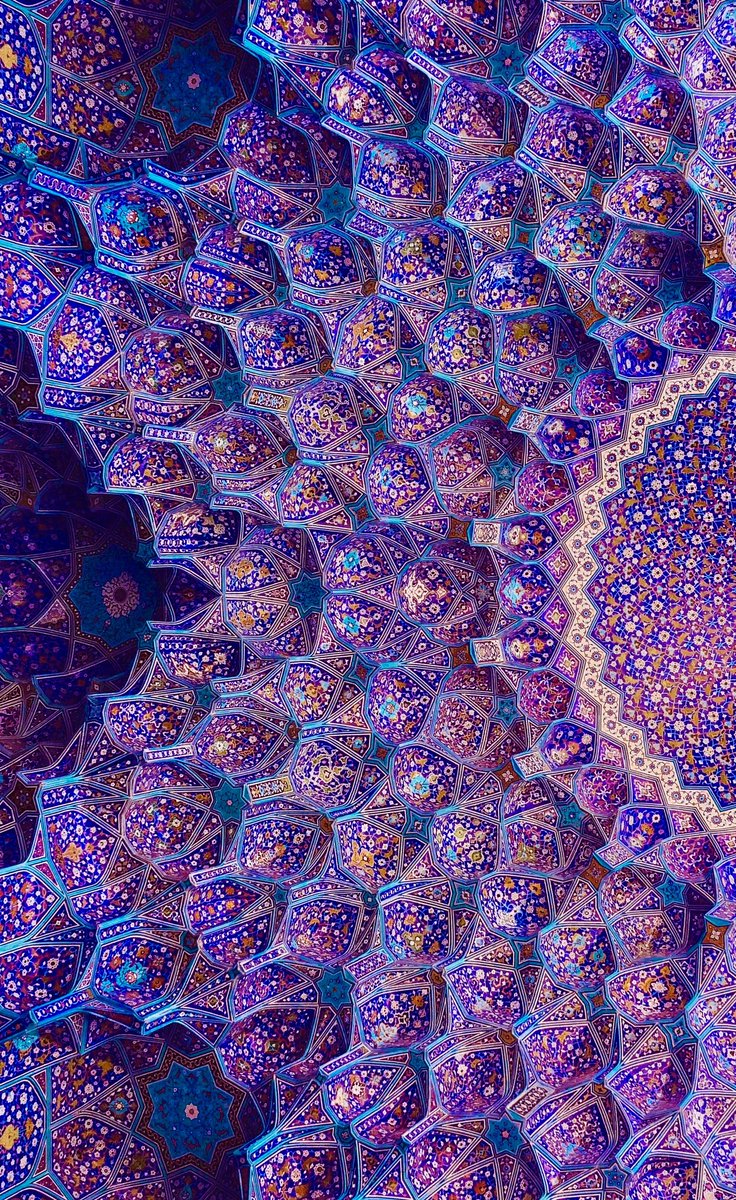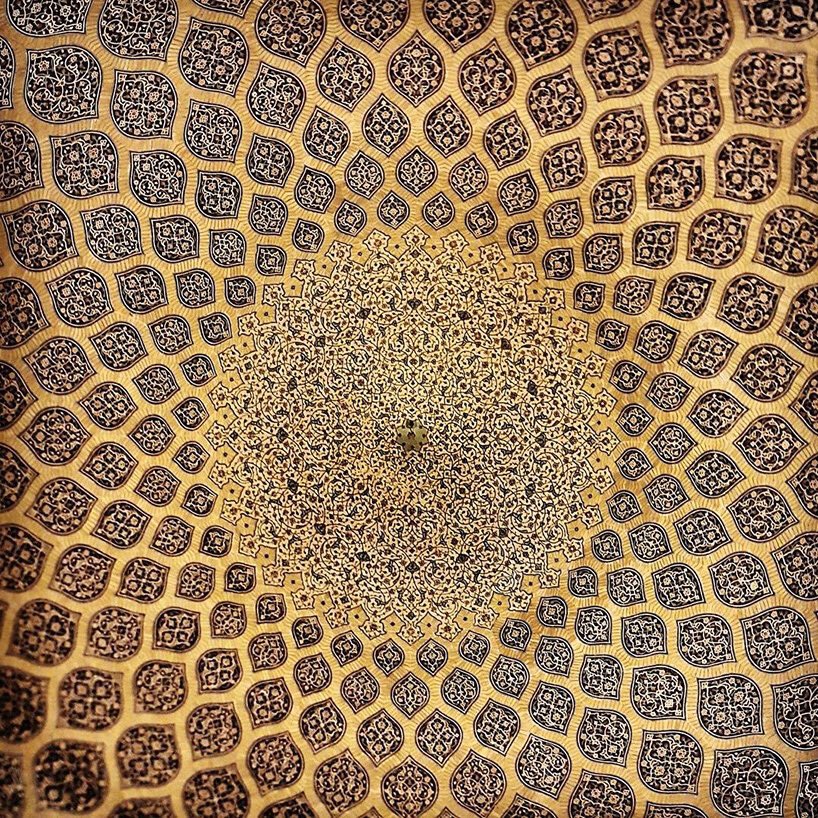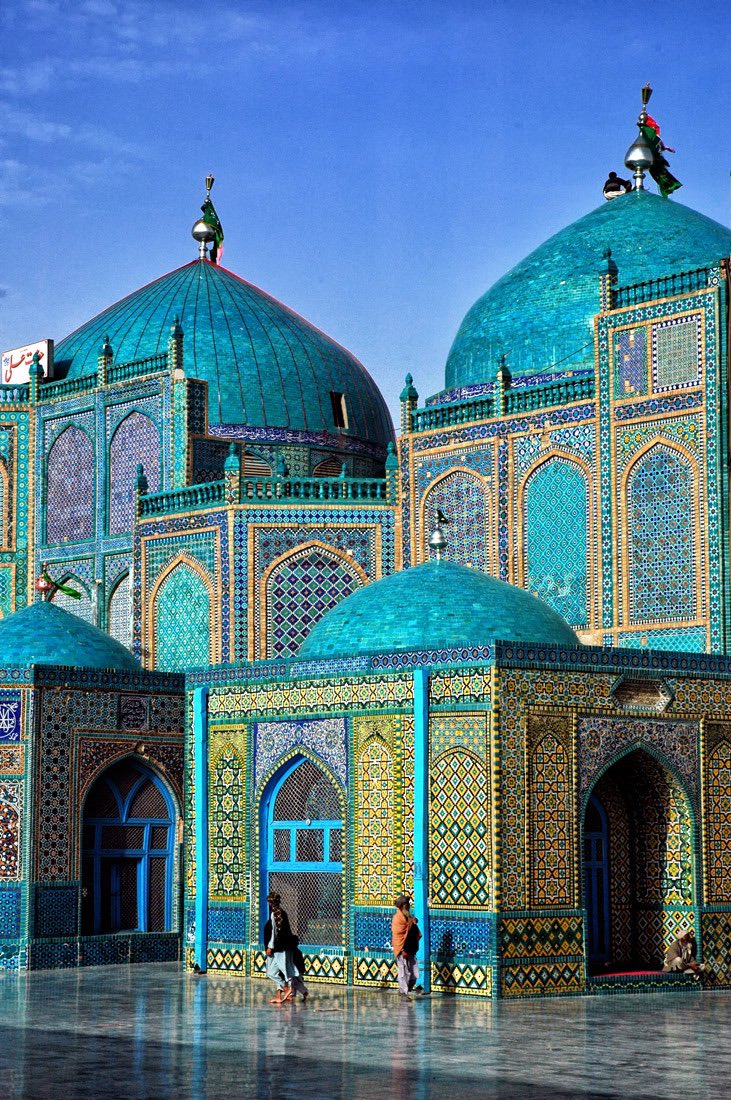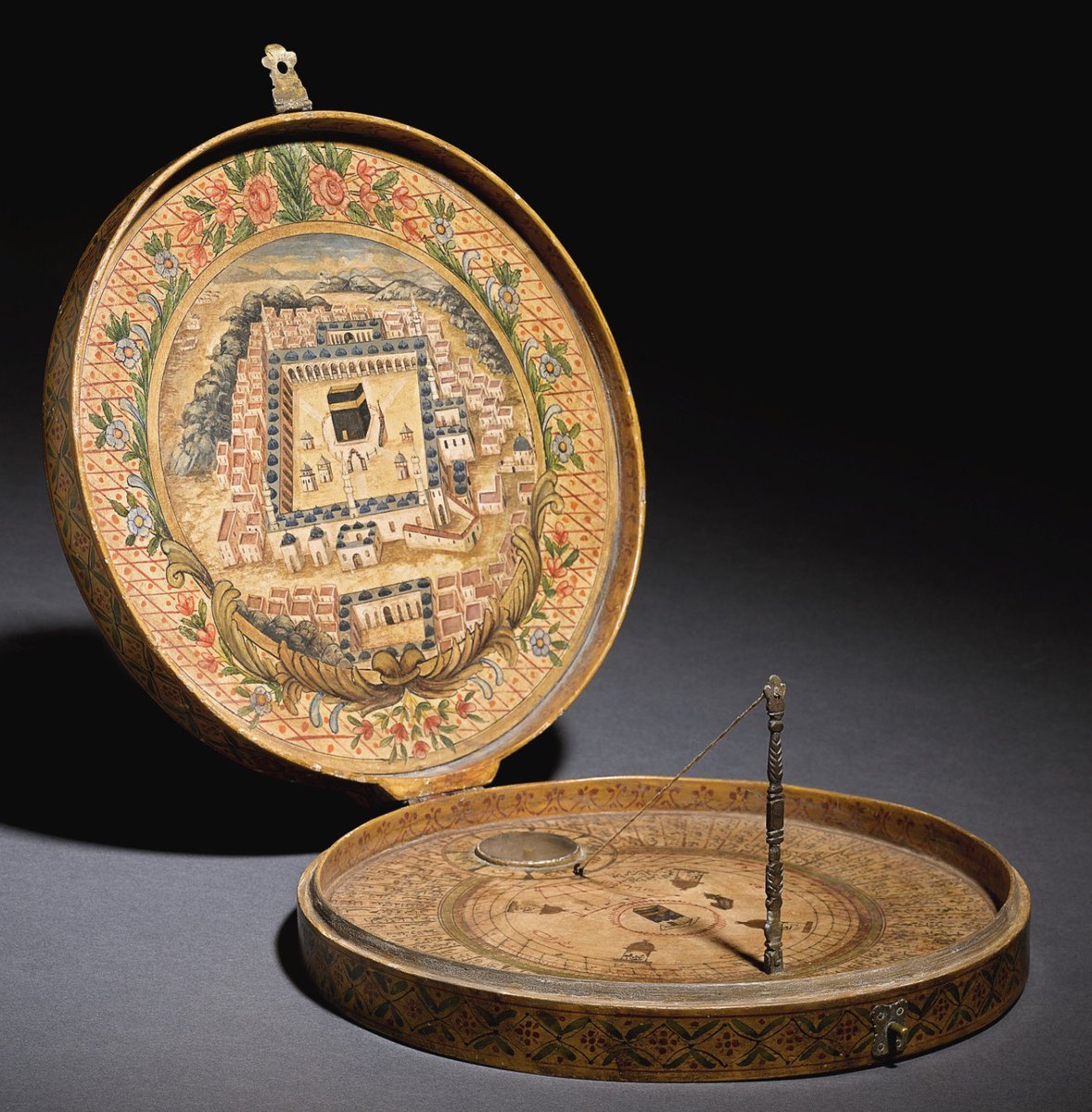
During the last 10 nights of Ramadan, many Muslims spend more time in Mosques in contemplation & prayer.
Mosque ceilings are designed to reflect the magnificence of the universe.
For Ramadan, here are spectacular details of 24 Mosque ceilings from around the world…
A thread…
Mosque ceilings are designed to reflect the magnificence of the universe.
For Ramadan, here are spectacular details of 24 Mosque ceilings from around the world…
A thread…

1/ Jami Mosque, Andijan, Uzbekistan
The construction of the madrasah began in 1883 and lasted for 7 years. It has a gorgeous fretwork of wooden columns supporting a ceiling decorated with bright patterns made of a combination of geometrical ornaments & vegetal elements #Ramadan
The construction of the madrasah began in 1883 and lasted for 7 years. It has a gorgeous fretwork of wooden columns supporting a ceiling decorated with bright patterns made of a combination of geometrical ornaments & vegetal elements #Ramadan

2/ Sheikh Lotfollah Mosque, Naqsh-i Jahan Square, Esfahan, Iran
Construction of the mosque started in 1603 and was finished in 1619. Built by the chief architect Mohammadreza Isfahani, during the reign of Shah Abbas I of Persia. Beautiful interior dome details #Ramadan
Construction of the mosque started in 1603 and was finished in 1619. Built by the chief architect Mohammadreza Isfahani, during the reign of Shah Abbas I of Persia. Beautiful interior dome details #Ramadan

3/ Jameh Mosque, Yazd, Iran
The 14th-century mosque is still in use today. It was first built under Ala'oddoleh Garshasb of the Al-e Bouyeh dynasty. It was largely rebuilt between 1324 and 1365. The ceiling was built like a porch in the heart of the desert #Ramadan
The 14th-century mosque is still in use today. It was first built under Ala'oddoleh Garshasb of the Al-e Bouyeh dynasty. It was largely rebuilt between 1324 and 1365. The ceiling was built like a porch in the heart of the desert #Ramadan

4/ Tokyo Mosque, (東京ジャーミイ), Ōyama-chō district of Shibuya ward in Tokyo, Japan
It is the largest mosque in Japan. Originally built in 1938, the current building was completed in 2000. It was designed by Hilmi Senalp, in a style inspired by Ottoman architecture #Ramadan
It is the largest mosque in Japan. Originally built in 1938, the current building was completed in 2000. It was designed by Hilmi Senalp, in a style inspired by Ottoman architecture #Ramadan

5/ Shah Mosque in Tehran, Iran
Built to the order of Fath-Ali Shah Qajar of Persia during the Qajar period, as one of several such symbols of legitimacy for the new dynasty. Construction started in 1810 and completed in 1825. These are divine details from the ceiling #Ramadan
Built to the order of Fath-Ali Shah Qajar of Persia during the Qajar period, as one of several such symbols of legitimacy for the new dynasty. Construction started in 1810 and completed in 1825. These are divine details from the ceiling #Ramadan

6/ Sultan Qaboos Grand Mosque, Oman
In 1992, Qaboos bin Said al Said, the then Sultan of Oman, directed that his country should have a Grand Mosque, construction commenced in December 1994. The chandelier above the praying hall is 14 metres (46 feet) tall #Ramadan
In 1992, Qaboos bin Said al Said, the then Sultan of Oman, directed that his country should have a Grand Mosque, construction commenced in December 1994. The chandelier above the praying hall is 14 metres (46 feet) tall #Ramadan

7/ Al-Askari Mosque, Samarra, Salah al-Din Governorate, Northern Iraq
It was built in 944 and is a Shia Muslim mosque and mausoleum in the Iraqi city of Samarra 125 km (78 mi) from Baghdad. It is one of the most important Shia shrines in the world & decorated in tiles #Ramadan
It was built in 944 and is a Shia Muslim mosque and mausoleum in the Iraqi city of Samarra 125 km (78 mi) from Baghdad. It is one of the most important Shia shrines in the world & decorated in tiles #Ramadan

8/ Bolo Haouz Mosque, Bukhara, Uzbekistan
Built in 1712, on the opposite side of the citadel of Ark in Registan district. Thin columns made of painted wood were added to the frontal part of the iwan (entrance) in 1917. The columns are decorated with colored muqarnas #Ramadan
Built in 1712, on the opposite side of the citadel of Ark in Registan district. Thin columns made of painted wood were added to the frontal part of the iwan (entrance) in 1917. The columns are decorated with colored muqarnas #Ramadan

9/ Jama Masjid, Delhi, India
Built by Mughal Emperor Shah Jahan between 1650 & 1656, & inaugurated by its first Imam, Syed Abdul Ghafoor Shah Bukhari. Situated in Old Delhi, it served as the imperial mosque of the Mughal emperors until the end of the empire in 1857
#Ramadan
Built by Mughal Emperor Shah Jahan between 1650 & 1656, & inaugurated by its first Imam, Syed Abdul Ghafoor Shah Bukhari. Situated in Old Delhi, it served as the imperial mosque of the Mughal emperors until the end of the empire in 1857
#Ramadan

10/ Nasir Al Mulk, Shiraz, Iran
Built during the Qajar dynasty in 1876 by the order of Mirza Hassan Ali Nasir-ol-Mulk, and was completed in 1888. The designers were Mohammad Hasan-e-Memār, Mohammad Hosseini Shirazi, and Mohammad Rezā Kāshi-Sāz-e-Širāzi #Ramadan
Built during the Qajar dynasty in 1876 by the order of Mirza Hassan Ali Nasir-ol-Mulk, and was completed in 1888. The designers were Mohammad Hasan-e-Memār, Mohammad Hosseini Shirazi, and Mohammad Rezā Kāshi-Sāz-e-Širāzi #Ramadan

11/ Al-Masjid an-Nabawi Masjid, Medina, Saudi Arabia
Built by Prophet Muhammad (PBUH) it was the second mosque built in Medina after Masjid Quba', and is the second largest mosque and second holiest site in Islam, both titles ranking after the Masjid al-Haram in Mecca #Ramadan
Built by Prophet Muhammad (PBUH) it was the second mosque built in Medina after Masjid Quba', and is the second largest mosque and second holiest site in Islam, both titles ranking after the Masjid al-Haram in Mecca #Ramadan

12/ Wazir Khan Mosque, Lahore, Pakistan
Built in 1641 it is considered the most ornately decorated Mughal-era mosque, and is renowned for its intricate faience tile work known as kashi-kari, as well as its interior surfaces that are embellished with Mughal-era frescoes #Ramadan
Built in 1641 it is considered the most ornately decorated Mughal-era mosque, and is renowned for its intricate faience tile work known as kashi-kari, as well as its interior surfaces that are embellished with Mughal-era frescoes #Ramadan

13/ Hafez Tomb, Shiraz, Iran
Built in 1773 in memory of the celebrated Persian poet Hafez. The open pavilion structures are situated in the Musalla Gardens on the north bank of a seasonal river and house the marble tomb of Hafez #Ramadan
Built in 1773 in memory of the celebrated Persian poet Hafez. The open pavilion structures are situated in the Musalla Gardens on the north bank of a seasonal river and house the marble tomb of Hafez #Ramadan

14/ Badshahi Mosque, Pakistan
Built by Mughal emperor Aurangzeb between 1671 & 1673 it was the largest mosque in the world from 1673 to 1986. An important example of Mughal architecture, with an exterior that is decorated with carved red sandstone with marble inlay #Ramadan
Built by Mughal emperor Aurangzeb between 1671 & 1673 it was the largest mosque in the world from 1673 to 1986. An important example of Mughal architecture, with an exterior that is decorated with carved red sandstone with marble inlay #Ramadan

15/ Kul Sharif Mosque, Kazan, Tatarstan
Originally, the mosque was built in the Kazan Kremlin in the 16th century. It was named after Kul Sharif, who was a religious scholar who served there #Ramadan
Originally, the mosque was built in the Kazan Kremlin in the 16th century. It was named after Kul Sharif, who was a religious scholar who served there #Ramadan

16/ Interior details from a Mosque, near Erbil Citadel, Iraq
Multicoloured ceiling with verses written from the Qur’an #Ramadan
Multicoloured ceiling with verses written from the Qur’an #Ramadan

17/ The Great Mosque of Muhammad Ali Pasha, Cairo, Egypt
Commissioned by Muhammad Ali Pasha between 1830 & 1848.
Situated on the summit of the citadel this Ottoman mosque was the largest built in the first half of the 19th century & is the most visible mosque in Cairo #Ramadan
Commissioned by Muhammad Ali Pasha between 1830 & 1848.
Situated on the summit of the citadel this Ottoman mosque was the largest built in the first half of the 19th century & is the most visible mosque in Cairo #Ramadan

18/ The Sheikh Zayed Grand Mosque, Abu Dhabi, United Arab Emirates
The largest mosque in the country, it was constructed between 1994 & 2007. The project was launched by the late president of the United Arab Emirates (UAE), Sheikh Zayed bin Sultan Al Nahyan #Ramadan
The largest mosque in the country, it was constructed between 1994 & 2007. The project was launched by the late president of the United Arab Emirates (UAE), Sheikh Zayed bin Sultan Al Nahyan #Ramadan

19/ Cambridge Central Mosque, Cambridge, England
Completed in 2019. Europe’s first eco-sustainable mosque, its design incorporates local architecture, Islamic motifs & the use of timber to create interwoven pillars that form an octagonal canopy evoking a calming oasis #Ramadan
Completed in 2019. Europe’s first eco-sustainable mosque, its design incorporates local architecture, Islamic motifs & the use of timber to create interwoven pillars that form an octagonal canopy evoking a calming oasis #Ramadan

20/ Tila Kari, Samarkand, Uzbekistan
Commissioned a decade after the adjacent Shir Dar madrasa (1619-1636). The last, largest and most embellished structure of the famed Registan Square. It's name means ''gold-covered', referring to the decoration of its domed chamber #Ramadan
Commissioned a decade after the adjacent Shir Dar madrasa (1619-1636). The last, largest and most embellished structure of the famed Registan Square. It's name means ''gold-covered', referring to the decoration of its domed chamber #Ramadan

21/ Mazari Sharif, Afghanistan
Many Afghanis believe Ali ibn Abi Talib is buried here. The building gives the city, Mazari Sharif (meaning "Tomb of the Exalted") its name. The shrine was erected here in 1136 and the interior ceiling is a splendour of colour #Ramadan
Many Afghanis believe Ali ibn Abi Talib is buried here. The building gives the city, Mazari Sharif (meaning "Tomb of the Exalted") its name. The shrine was erected here in 1136 and the interior ceiling is a splendour of colour #Ramadan

22/ The Sultan Ahmed Mosque, Turkey
An Ottoman-era historical imperial mosque located in Istanbul, Turkey. A functioning mosque, it also attracts large numbers of tourist visitors. It was constructed between 1609 and 1616 during the rule of Ahmed I #Ramadan
An Ottoman-era historical imperial mosque located in Istanbul, Turkey. A functioning mosque, it also attracts large numbers of tourist visitors. It was constructed between 1609 and 1616 during the rule of Ahmed I #Ramadan

23/ Imam Reza shrine, Mashhad, Iran
Contains the mausoleum of Imam Reza and is the largest mosque in the world by area. It was built in 821 AH under the orders of Gowharshad Khatun, Shahrokh Mirza's wife #Ramadan
Contains the mausoleum of Imam Reza and is the largest mosque in the world by area. It was built in 821 AH under the orders of Gowharshad Khatun, Shahrokh Mirza's wife #Ramadan

24/ The Putra Mosque, Putrajaya, Malaysia
Building began in 1997 & completed two years later. The pink-domed Mosque is constructed with rose-tinted granite & includes a prayer hall, courtyard & learning facilities. The mosque can accommodate 15,000 worshippers #Ramadan
Building began in 1997 & completed two years later. The pink-domed Mosque is constructed with rose-tinted granite & includes a prayer hall, courtyard & learning facilities. The mosque can accommodate 15,000 worshippers #Ramadan

Thank you so much for sharing @cricketwallah #RamadanKareem
• • •
Missing some Tweet in this thread? You can try to
force a refresh





















